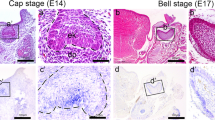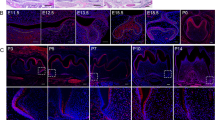Abstract
Adenomatosis polyposis coli downregulated 1 (APCDD1), a negative regulator of Wnt signaling, was examined to understand detailed mechanisms underlying Wnt signaling tooth development. In situ hybridization showed that Apcdd1 was expressed in the condensed mesenchyme at the bud stage, and in the inner enamel epithelium (IEE), including enamel knot (EK) at the cap stage. In vitro organ cultivation by using Apcdd1 antisense oligodeoxynucleotides was performed at E13.5 for 2 days to define the developmental functions of APCDD1 during tooth development. Analysis of histogenesis and cellular events such as cell adhesion, proliferation, apoptosis and epithelial rearrangement after Apcdd1 knockdown showed altered morphogenesis of the tooth germ with decreased cell proliferation and altered localization of cell adhesion molecules. Actin filament staining and 1,1′-dioctadecyl-3,3,3′,3′-tetramethylindocarbocyanine perchlorate (DiI) labeling of IEE cells showed that Apcdd1 knockdown enhanced epithelial rearrangement in the IEE and EK. To understand the precise signaling regulations of Apcdd1, we evaluated the altered expression patterns of signaling molecules, related with Wnt and enamel knot signalings using RT-qPCR. Tooth germs at cap stage were transplanted into the kidney capsules and were allowed to develop into calcified teeth for 3 weeks. Apcdd1 knockdown increased the number of ectopic cusps on the mesial side of the tooth. Our results suggested that APCDD1 modulates the gene expression of Wnt- and EK-related signaling molecules at the cap stage of tooth development, and is involved in tooth cusp patterning by modulating the epithelial rearrangement in the IEE.






Similar content being viewed by others
References
Biggs LC, Mikkola ML (2014) Early inductive events in ectodermal appendage morphogenesis. Semin Cell Dev Biol 25–26:11–21
Cho SW, Lee HA, Cai J, Lee MJ, Kim JY, Ohshima H, Jung HS (2007) The primary enamel knot determines the position of the first buccal cusp in developing mice molars. Differentiation 75:441–451
Cobourne MT, Sharpe PT (2005) Sonic hedgehog signaling and developing tooth. Curr Top Dev Biol 65:255–287
Coin R, Lesot H, Vonesch JL, Haikel Y, Ruch JV (1999) Aspects of cell proliferation kinetics of the inner dental epithelium during mouse molar and incisor morphogenesis: a reappraisal of the role of the enamel knot area. Int J Dev Biol 43:261–267
Halbleib JM, Nelson WJ (2006) Cadherins in development: cell adhesion, sorting, and tissue morphogenesis. Genes Dev 20:3199–3214
Jarvinen E, Salazar-Ciudad I, Birchmeier W, Taketo MM, Jernvall J, Thesleff I (2006) Continuous tooth generation in mouse is induced by activated epithelial Wnt/beta-catenin signaling. Proc Natl Acad Sci USA 103:18627–18632
Jernvall J, Thesleff I (2000) Reiterative signaling and patterning in mammalian tooth morphogenesis. Mech Dev 92:19–29
Jernvall J, Thesleff I (2012) Tooth shape formation and tooth renewal: evolving with the same signals. Development 139:3487–3497
Jernvall J, Kettunen P, Karavanova I, Martin LB, Thesleff I (1994) Evidence for the role of the enamel knot as a control center in mammalian tooth cusp formation: non-dividing cells express growth stimulating Fgf-4 gene. Int J Dev Biol 38(3):463–469
Jukkola T, Sinjushina N, Partanen J (2004) Drapc1 expression during mouse embryonic development. Gene Expr Patterns 4:755–762
Kassai Y, Munne P, Hotta Y, Penttila E, Kavanagh K, Ohbayashi N, Takada S, Thesleff I, Jernvall J, Itoh N (2005) Regulation of mammalian tooth cusp patterning by ectodin. Science 309:2067–2070
Liu F, Chu EY, Watt B, Zhang Y, Gallant NM, Andl T, Yang SH, Lu MM, Piccolo S, Schmidt-Ullrich R, Taketo MM, Morrisey EE, Atit R, Dlugosz AA, Miller SE (2008) Wnt/beta catenin signaling directs multiple stage of tooth morphogenesis. Dev Biol 313:210–224
Loes S, Luukko K, Kvinnsland IH, Kettunen P (2001) Slit1 is specifically expressed in the primary and secondary enamel knots during molar tooth cusp formation. Mech Dev 107:155–157
Martinez-Rico C, Pincet F, Thiery JP, Dufour S (2009) Integrins stimulate E-cadherin mediated intercellular adhesion by regulating Src-kinase activation and actomyocin contractility. J Cell Sci 123:712–722
Neupane S, Sohn WJ, Rijal G, Lee YJ, Lee S, Yamamoto H, An CH, Cho SW, Lee Y, Shin HI, Kwon TY, Kim JY (2014) Developmental regulations of Perp in mice molar morphogenesis. Cell Tissue Res 358(1):109–121
Obara N, Lesot H (2004) Subcellular localization of beta-catenin and cadherin expression in the cap-stage enamel organ of the mouse molar. Histochem Cell Biol 121:352–358
Obara N, Lesot H (2007) Asymmetrical growth, differential cell proliferation and dynamic cell rearrangement underlie epithelial morphogenesis in mouse molar. Cell Tissue Res 330:461–473
Otsu K, Kishigami R, Fujiwara N, Ishizeki K, Harada H (2011) Functional role of rho-kinase in ameloblast differentiation. J Cell Physiol 226:2527–2534
Palacios J, Benito N, Berraquero R, Pizarro A, Cano A, Gamallo C (1995) Differential spatiotemporal expression of E- and P-cadherin during mouse tooth development. Int J Dev Biol 39:363–666
Pispa J, Thesleff I (2003) Mechanisms of ectodermal organogenesis. Dev Biol 262(2):195–205
Pispa J, Mustonen T, Mikkola ML, Kangas AT, Koppinen P, Lukinmaa PL, Jernvall J, Thesleff I (2004) Tooth patterning and enamel formation can be manipulated by misexpression of TNF receptor Edar. Dev Dyn 231:432–440
Rallis C, Pinchin SM, Ish-Horowicz D (2010) Cell-autonomous integrin control of Wnt and Notch signaling during somitogenesis. Development 137:3591–3601
Salmivirta K, Gullberg D, Hirsch E, Altruda F, Ekblom P (1996) Integrin subunit expression associated with epithelial-mesenchymal interactions during murine tooth development. Dev Dyn 205(2):104–113
Shimomura Y, Agalliu D, Vonica A, Luria V, Wajid M, Baumer A, Belli S, Petukhova L, Schinzel A, Brivanlou AH, Barres BA, Christiano AM (2010) APCDD1 is a novel Wnt inhibitor mutated in hereditary hypotrichosis simplex. Nature 464:1043–1047
Sohn WJ, Yamamoto H, Shin HI, Ryoo ZY, Lee S, Bae YC, Jung HS, Kim JY (2011) Importance of region specific epithelial rearrangements in mouse rugae development. Cell Tissue Res 344:271–277
Sohn WJ, Choi MA, Yamamato H, Lee S, Lee Y, Jung JK, Jin MU, An CH, Jung HS, Shin HI, Kim JY (2014) Contribution of mesenchymal proliferation in tooth root morphogenesis. J Dent Res 93(1):78–83
Stewart GA, Lowrey JA, Wakelin SJ, Fitch PA, Lindey S, Dallman MJ, Lamb JR, Howie SE (2002) Sonic hedgehog signaling modulates activation of and cytokine production by human peripheral CD4+ T cells. J Immunol 169(10):5451–5457
Takahashi M, Fujita M, Furukawa Y, Hamamoto R, Shimokawa T, Miwa N, Oqawa M, Nakamura Y (2002) Isolation of a novel human gene, APCDD1, as a direct target of the b-catenin/T-cell factor 4 complex with probable involvement in colorectal carcinogenesis. Cancer Res 62:5651–5656
Thesleff I (2003) Epithelial-mesenchymal signalling regulating tooth morphogenesis. J Cell Sci 116:1647–1648
Thesleff I, Mikkola M (2002) The role of growth factors in tooth development. Int Rev Cytol 217:93–135
Tsai SY, Sennett R, Rezza A, Clavel C, Grisanti L, Zemla R, Najam S, Rendl M (2014) Wnt/β-catenin signaling in dermal condensates is required for hair follicle formation. Dev Biol 385(2):179–188
Tummers M, Thesleff I (2009) The importance of signal pathway modulation in all aspect of tooth development. J Exp Zool B Mol Dev Evol 312B(4):309–319
Vaahtokari A, Åbert T, Jernvall J, Keränen S, Thesleff I (1996) The enamel knot as a signaling center in the developing mouse tooth. Mech Dev 54:39–43
Wang XP, O’Connell DJ, Lund JJ, Saadi I, KuraguchiM Turbe-Doan A, Cavallesco R, Kim H, Park PJ, Harada H, Kucherlapati R, Maas RL (2009) Apc inhibition of Wnt signaling regulates supernumerary tooth formation during embryogenesis and throughout adulthood. Development 136:1939–1949
Williams-Masson EM, Heid PJ, Lavin CA, Hardin J (1998) The cellular mechanism of epithelial rearrangement during morphogenesis of Caenorhabditis elegans dorsal hypodermis. Dev Biol 204(1):263–276
Acknowledgments
This study was supported by a National Research Foundation of Korea (NRF) Grant funded by the Korean Government (MSIP; No. 2008–0062282).
Author information
Authors and Affiliations
Corresponding author
Electronic supplementary material
Below is the link to the electronic supplementary material.
Supplementary Figure 1
Graphical presentation of buccolingual diameter (a), number of TUNEL-positive cells in the EK (b) and number of Ki67-positive cells in the IEE (c). The scheme for counting IEE cells (d). The shaded area indicates the region from which Ki67-positive cells were counted (d); **p < 0.01. EK, enamel knot; IEE, inner enamel epithelium (TIFF 4687 kb)
Supplementary Figure 2
Altered expression of Wnt signaling-related signaling molecules in tooth germ cultivated at E13 for 2 days (TIFF 769 kb)
Supplementary Figure 3
Whole-mount in situ hybridization of Fgf4 after in vitro cultivation at E15.5 for 3 days. The AS-ODN-treated specimen showing increased number of Fgf4 expression spots on the mesial and distal parts of the tooth germ compared with that in the control specimen (a, b). The arrows indicate increased Fgf4 expression. Bu, buccal; Di, distal; Li, lingual; Me, mesial. Scale bars: 200 μm (TIFF 590 kb)
Rights and permissions
About this article
Cite this article
Neupane, S., Sohn, WJ., Gwon, GJ. et al. The role of APCDD1 in epithelial rearrangement in tooth morphogenesis. Histochem Cell Biol 144, 377–387 (2015). https://doi.org/10.1007/s00418-015-1345-z
Accepted:
Published:
Issue Date:
DOI: https://doi.org/10.1007/s00418-015-1345-z




